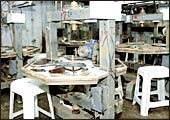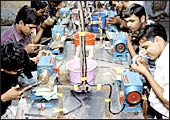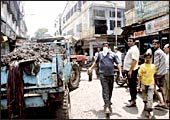 |
| Flooded with problems: It
will be several months before Surat gets its sparkle back |
 |
| Pandol, one of Surat's biggest
diamond hubs, is the worst hit. There are some 350 diamond
units in its Industrial Estate No. 1. More than a quarter
of them have done no work since the place first got flooded
on August 7 |
It's
been 19 days since the floods receded in Pandol, but late August,
the situation still looks grim. Heaps of garbage dot the narrow
and still very marshy bylanes, and a strong but indistinct odour
hangs thick in the air. The only people out in the streets cleaning
the muck up seem to be Pandol's diamond entrepreneurs. Not surprising.
Pandol is one of Surat's biggest diamond hubs and its industrial
belt, called Industrial Estate No. 1, has been the worst affected.
There are some 350 diamond units here, but more than a quarter
of them have done no work since the place first got flooded on
August 7. "To us, August-September is the busiest season
every year, and that at present is looking like a lost opportunity,"
says Vijay Sangani, a manager at Pandol's Vitrag Diamonds.
Elsewhere in Surat, things are no better.
With an annual turnover of Rs 45,000 crore from diamonds, Surat
is the heart of India's diamond industry, accounting for 90 per
cent of the country's diamond business. Significantly, of every
Rs 100 worth of diamonds finished, Rs 90 is exported. There are
about 4,000 diamond units in all, including those that cut, polish
and finish diamonds, with the smallest unit pulling in Rs 10 crore
a year and the biggest, as much as Rs 1,500 crore. Since the business
is relatively low skilled and labour intensive, margins are wafer
thin at 3-5 per cent, and all the units are in a constant battle
to cut costs and maintain revenues without compromising on quality.
Driving through Surat, it is evident that
the floods will take a big toll of the diamond units. Compared
to the 1998 flooding of the city (then described as the worst-ever
in Surat's history), this year's inundated five times the area
and lasted three times longer. Initial estimates put the losses
at between Rs 3,000 crore and Rs 5,000 crore (this does not include
losses of the local textile industry, the other big money-spinner
for Surat). Babubhai B. Viradia, Secretary, Surat Diamond Association,
gives the break up. Loss of production over 15 days: Rs 1,400
crore; loss from damaged machinery: Rs 400 crore; and personal
loss to workers from things like damaged homes, Rs 100 crore.
But that still doesn't add up to Rs 3,000 crore. So, why are diamond
entrepreneurs like Viradia fearing the worst? Because no one is
really sure when Surat's cutting and polishing tables will start
whirring again.
 |
| Surat Diamond Association's Viradia:
Given the extent of damage and losses, he isn't sure when
business will go back to normal |
Industry Of Immigrants
Most of the workers in Surat's diamond industry
(including skilled, semi-skilled and unskilled workers) are not
from Surat, but come from states such as Uttar Pradesh, Bihar
and Rajasthan. Typically, seven out of every 10 workers at a diamond
factory is an immigrant, and when the floods hit the city, most
of them fled to their homes. "The worrying part is that they
are likely to get back only after Diwali and that means we have
in one stroke lost the biggest season," points out Jayesh
Patel, who owns M.V. Enterprise. His company has an export oriented
unit (EOU) in Pandol that is all but destroyed. "Out of a
total workforce of 200, we are down to just 30," laments
Patel. Every diamond unit has a circular table that can accommodate
four workers at one time, but at Patel's Pandol unit, just three
of 60 such machines are working. With great difficulty, Patel
has managed to give his unit some semblance of normalcy by rigging
up make-shift tube lights to allow a handful of workers to resume
work. His biggest concern now is two-fold: How to get production
fully back on track and how to manage costs, since not only has
his firm lost revenues, but it has had to continue paying worker
salaries. In fact, that's a challenge that confronts every single
unit in Surat today.
 |
| Kiah's Naik: Last August, he did total
sales of Rs 22 lakh. This August, it was barely Rs 2 lakh.
For him and others, it has been a bleak start to the festive
season |
Factories that have been spared damage to
their machinery, such as Surbhi Gems' elevated unit at Mini Bazaar
district, have other worries to grapple with. "At least 70
per cent of our staff has been with us for about six years and
they are a very experienced lot. Our fear is that more will go
away," says Lalubhai Kunt of Surbhi, which employs about
1,000 workers. (That means even if Surbhi manages to get new workers,
they may not deliver the same quality or productivity.) The workers
who stayed back did so not because they wanted to, but because
they had no choice. "There is not much to do at home, although
I have some land. Besides, (farming) is quite unpredictable,"
says Kamlesh, who hails from Bihar and works at Harikrishna Gems.
What makes matters worse for the industry
here is the fact that most of the units have not bothered to get
an insurance cover. "The problem is with the trade itself,
since it is not very transparent in its dealings," says a
Surat-based senior insurance official. "There are insurance
companies offering policies specifically for the diamond and jewellery
business, but it is only the larger players that have opted for
them," he adds. The local industry does have an insurance
system of its own, but it is meant for the workers and not the
businesses. Two years ago, the industry association launched a
scheme that allowed a worker to get personal accident insurance
of Rs 1 lakh by paying a premium of Rs 225 per annum. However,
says the association's Viradia, the response to the scheme has
been poor. Out of Surat's total diamond workforce of 70,000, only
20,000 have signed up for the insurance scheme. Needless to say,
had the city's diamond units or their workers opted for proper
insurance, the story today would have been very different.
 |
| Most of Surat's workers come from
other states. Typically, seven out of every 10 workers at
a diamond unit is an immigrant, and when the floods came,
most of them fled to their homes. And they are likely to return
only after Diwali |
 |
| Surbhi's Kunt: With many
of his experienced workers having fled the city, he worries
about quality and productivity |
As mentioned earlier, this is not the first
time that Surat has been hit with flash floods. Back in 1998,
a similar flood ravaged the city. In both instances, it wasn't
just rains, but water released from the nearby Ukai dam that caused
the flooding. According to estimates, this time around, up to
80 per cent of Surat remained under water (between two and 20-feet,
depending on the location) for five days. The state government
has set up a one-member panel to probe allegations of negligence
by dam officials. The panel will submit its report by December
31, 2006. "The diamond industry here is not a very educated
community and owners of smaller units, for instance, do not understand
the benefits of things like insurance," says Viradia, explaining
why the city doesn't seem to have learnt from the experience six
years ago.
Industry at Risk
Surat's plight will inevitably tell on India's
gems and jewellery exports. India is the world's biggest processor
of stones, cutting and polishing 11 out of every 12 diamonds.
Last year, the country exported Rs 68,686- crore worth of gems
and jewellery, accounting for 15 per cent of total exports. Given
that Surat accounts for 90 per cent of the industry's output by
value, exports will take a big knock this year. According to the
Mumbai-based Gem & Jewellery Export Promotion Council (GJEPC),
while there has been no loss of stocks in trade, the estimated
production loss has amounted to $60 million or Rs 282 crore. "The
floods have disturbed the entire supply cycle of diamonds to the
international markets and as clients do not carry huge inventories,
the total exports of gems and jewellery is likely to receive a
setback," said Bakul R. Mehta, Chairman, GJEPC, in a statement.
However, some of the Surat-based factory
owners say that there is no danger of buyers moving to a different
sourcing destination, since no other country (at least in small
diamonds) is as competitive as India. "We have had long-standing
relationships with our clients and we have managed to extend deadlines,"
says Viradia. "They also realise that the city is going through
a rough phase."
 |
| What makes matters worse is that
most of the units have not bothered to get an insurance cover.
Had the diamond units or their workers opted for proper insurance,
the story today would have been very different |
|
|
| M.V. Enterprise's Patel: His
company has a 100 per cent export-oriented unit in Pandol
that is all but destroyed |
Meanwhile, the Surat diamond industry, through
its association, has made a formal representation to the state
government, and one of the demands is for soft loans for workers.
"The workers are referred to as ratna kalakaar and they are
the backbone of this industry," he says. "We have also
asked for help on replacing our machinery and some concessions
on the vat (value added tax) front, besides deferment of payments
on our loans."
If Surat's diamond industry feels emboldened
to ask for help, it's also because it has often come to the community's
aid in times of crisis. For example, after the 2001 earthquake
in Gujarat, diamond factory owners helped rebuild homes. But Chandrakant
Sanghavi, President, Gujarat Hira Bourse, and Chairman, Indian
Diamond Institute, says that the floods have come at an inopportune
time for the diamond business. "The industry has already
been in the midst of a recession for about six months now, and
the only thing that can help its cause is its own resilience,"
says Sanghavi.
With the people of Surat busy salvaging their
homes, the start of the festive season looks bleak. Kiah Diamond
Jewellery, located in upmarket Ghoddod Road, is among the city's
largest retailers and, therefore, quick to feel the pinch. "Last
August, we did a total sale of Rs 22 lakh and this August, we
are at barely Rs 2 lakh," informs store manager Dhirubhai
Naik. "At any point in time, we have at least 15 customers
in the store, but today I would be lucky if more than one customer
walked in," he says. Indeed, during the 40 minutes that this
reporter spent at the store, not a single customer walked in.
For a city that thrives on its "evening
trade"-be it diamond, textiles or entertainment-the floods
have delivered a huge blow. "Surat has always bounced back
from crisis and will do so this time as well," says Patel.
Those aren't just brave words. Rather, it is a simple statement
of intention. At Rs 45,000 crore a year, the stakes are simply
too high for Surat's diamond industry to sit around and mope.
|












